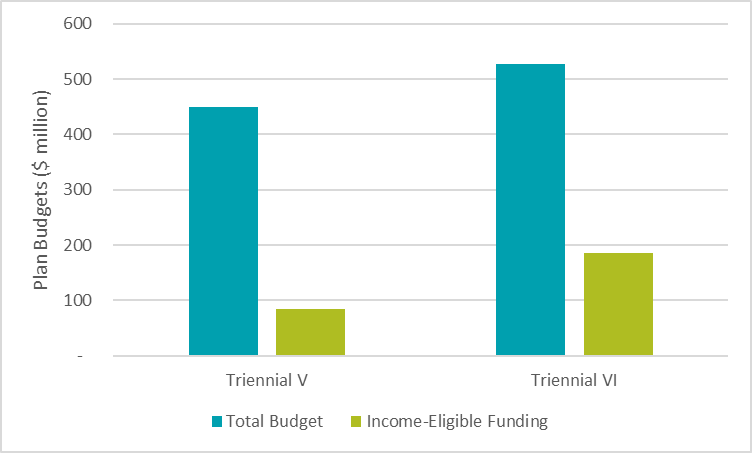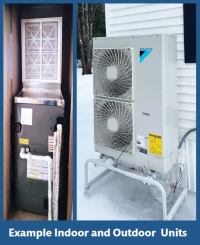

By Yiran He | Thu, May 29, 25
The Maine Public Utilities Commission has approved Triennial Plan VI, setting in motion the state’s next three-year cycle of energy efficiency programs which will run from July 1, 2025, through June 30, 2028. Administered by Efficiency Maine Trust (EMT), the plan lays out a wide-ranging set of initiatives with a 1-to-3.7 cost-benefit ratio. The table below shows the change in budgets and targets between Triennial Plans V and VI. Overall, Triennial Plan VI has increased targets for every metric except natural gas savings.
Targets for Full Three-Year Cycles | Change | ||
Total budget | $449 million ($85 million for LMI) | $528 million ($186 million for LMI) | ↑18% (↑119% for LMI) |
Electric savings | 168,075 MWh | 183,214 MWh | ↑9% |
Natural gas savings | 174,271 MMBtu | 141,971 MMBtu | ↓19% |
Heating oil and other fuels savings | 4,709,997 MMBtu | 4,898,176 MMBtu | ↑4% |
Summer peak demand savings | 114 MW | 137 MW | ↑21% |
Homes and businesses weatherized | 9,537 (2,913 for LMI homes) | 10,200 (3,300 for LMI homes) | ↑7% (↑13% for LMI homes) |
The plan also sets targets to support electrification and home efficiency upgrades. This includes targeting 38,000 homes heated entirely with heat pumps, of which 6,500 must be low-income households, and 9,900 homes weatherized, including 1,500 low-income, 1,800 moderate-income, and 6,600 all-income households. These targets will contribute to Maine’s statutory goals of reducing emissions by 45 percent by 2030 from 1990 levels and achieving carbon neutrality by 2045. Maine continues to be a leader in the region in implementing beneficial electrification programs and driving adoption of heat pumps for water and space heating.
This blog post highlights four key themes of the plan: increased focus on energy affordability, leading programs for building decarbonization, lowering costly grid peaks, and reaching schools and more households through program innovation.
Improving Energy Affordability with Federal Funds
Energy affordability is a pressing concern in Maine, where low-income households spent an average of 14 percent of their income on household energy in 2024, which is more than double the level of energy burden considered “high” of six percent. For Triennial Plan VI, EMT will significantly increase investment for income-eligible households. The state has also set a statutory goal to weatherize at least 10,000 low-income households cumulatively from 2020 to 2030 in coordination with MaineHousing. Triennial Plan VI takes steps to bring Maine toward that goal, but more will be needed to reach this level of weatherization.
Historically, EMT has faced several barriers in serving low-income customers, including high upfront costs, split incentives between tenants and landlords, specialized skill requirements for the workforce, and customer unfamiliarity with energy efficiency technologies and programs. Triennial Plan VI addresses these barriers with targeted funding, expanded contractor engagement, and enhanced outreach strategies.
Low-income customers are served by the Income-Eligible Homes Program, which provides incentives for insulation, weatherization, and heating systems. Triennial Plan VI commits $186 million to low-income programs, more than doubling the $85 million allocated in Triennial Plan V. That figure represents approximately 35 percent of the total Triennial Plan VI budget, up from 19 percent in the last plan as shown in Figure 1. Through this program, EMT offers rebates and incentives for high-efficiency equipment and weatherization measures, as well as targeted initiatives that focus on specific housing types, regions, or pilot projects. Low-income customers can also receive small, free energy-saving devices.
This increase is largely a result of nearly $72 million in Home Energy Rebates from the Inflation Reduction Act. These are a pair of programs targeted toward households: Home Electrification and Appliance Rebates (HEAR) offer funds for electric appliances and equipment, while Home Efficiency Rebates (HER) focuses on whole-house energy upgrades, including insulation and HVAC systems. While other states are targeting low-to-moderate income households with their rebate programs as required in the IRA, Maine is targeting the low-income sector by requiring that in the first year only low-income households can access the funds. Currently, HEAR is funding heat pump systems for low-income households in newly constructed multifamily buildings and in manufactured (mobile) homes. Maine plans to offer a second phase of HEAR, which will open up rebates for moderate income households. HER will fund efficiency retrofits for existing multifamily buildings, with higher rebates available for buildings serving low-income households.
Maine has also expanded its Manufactured (Mobile) Home Initiative through a $10 million competitive grant. For manufactured homes, EMT has scaled up a successful pilot into a permanent program that offers income-eligible homeowners using propane or kerosene to receive incentives toward installation of a ducted heat pump system. The estimated annual savings are $1,388 for homes switching from propane-heating and $958 for those switching from kerosene-heating.
EMT will track its progress on reaching income-eligible customers using metrics including weatherization and heat pump installations in low- and moderate-income households, as well as county-level distribution of incentives. Data is important to assess policy impacts and helps hold programs and institutions accountable. By tracking equity-related metrics, policymakers and implementers can establish a baseline and ensure measurable, real achievement.
Leading on Market Transformation and Building Decarbonization
Maine’s nation-leading progress in beneficial electrification continues with Triennial Plan VI. In previous years, the state has outpaced others in adoption of heat pump water heaters. In 2024, the state received the ACEEE “Leader of the Pack” award for achievements in residential beneficial electrification. ACEEE recognized Maine for its rapid expansion of heat pump and heat pump water heater installations, workforce training, and financial incentives targeted toward different markets. Highlights of EMT’s beneficial electrification work in the new plan include its whole-home heat pump requirement, midstream incentives, and workforce development networks.
The new plan continues to require full displacement and installation of whole home heat pump systems. The program was driven by the 2023 passage of the Beneficial Electrification Policy Act (BEPA), which mandates that EMT include all cost-effective electrification measures that reduce lifetime electricity rates. This policy shift has led to major program changes. As of September 2023, EMT’s Home Energy Savings Program offers incentives to market-rate customers for whole-home heat pump systems, meaning that the equipment must be sized to meet the full heating load of the home. Low-income customers remain eligible for incentives for partial load systems, i.e. supplemental systems.
To accelerate adoption, EMT offers midstream programs through the Retail and Distributor Initiatives for high-efficiency products such as heat pump water heaters, clothes washers, and other technologies. EMT negotiates instant discounts and stocking incentives with retailers and distributors. The budget for midstream programs in Triennial Plan VI is about 11 percent of the total budget.
Trusted contractors are essential to a positive customer experience in these programs. EMT’s contractor networks, the Residential Registered Vendors and the Qualified Partners, are essential to supporting contractors. To participate, contractors must provide certifications of training and licenses and complete training on cold climate heat pump sizing and design. In return, they receive support in accessing and understanding rebates and tax credits, listing on public-facing contractor-locating tools, training opportunities, and marketing materials. This ensures that contractors have access to up-to-date best practices in the industry and enables customers to find qualified contractors. There is room to offer more inclusive workforce development in the state. Maine offers the ReMaine program for clean energy internships through its Governor’s Energy Office. This program can serve as a model for EMT to consider to develop a diverse pipeline of talent for its programs.
Lowering Costly Grid Peaks through Demand-Side Solutions
One major program that is evolving is the Demand Management Program, which became a full offering last cycle after successful load-shifting pilots demonstrated their cost-effectiveness. The electric grid is sized to meet peak demand, so lowering peak demand decreases the investment necessary to maintain the grid. The program will start with three components: the Demand Response Initiative, which compensates non-residential participants for shifting electricity usage off-peak, the Distributed Energy Resources (DER) Initiative, which manages fleets of electric vehicle batteries and backup power systems in homes and businesses, and the Large Battery Initiative, which rewards non-residential customers with large batteries for providing power to the grid in the summer. EMT plans to pilot new load flexibility approaches and integrate them into the Demand Management Program as they demonstrate their cost-effectiveness and technical feasibility.
Reaching Maine Schools and More Households through Program Innovation
In Triennial Plan VI, EMT is adding new initiatives that invest in schools and inform homeowners. Changes to programs for school decarbonization and home energy scoring are strengthening EMT program impacts.
In 2021, LD 815 expanded EMT’s existing School Energy Savings Program, renaming it the School Decarbonization Program. The new legislation enables more comprehensive support beyond energy audits for K-12 schools to pursue decarbonization and carbon neutrality. For this cycle, EMT will continue to provide technical assistance for engineering studies, system design, legal services, and connection to available programs and contractors. EMT will also expand this program by creating an intake procedure to help more schools decarbonize and allowing schools to be eligible for light-duty electric vehicle rebates.
EMT’s plan offerings are further changing because of the 2023 passage of LD 1101, which established a Home Energy Scoring system for residential buildings that is now a full Triennial Plan VI offering. EMT designated one of five DOE-authorized Home Energy Score Partners to begin issuing scores in 2024. A home energy score can give homeowners, buyers, and renters an accessible and low-cost way to understand the current state of a home’s energy efficiency and actionable recommendations for reducing energy use and costs.
Looking Ahead
Maine’s Triennial Plan VI will reduce emissions, lower utility bills, and deliver cleaner, healthier homes and businesses. For participating households, the benefits are immediate and tangible. Even without weatherization, a typical Maine home switching to a heat pump system stands to save more than $600 annually on heating bills.
Looking ahead, analysis by National Renewal Energy Labortatory (NREL) shows that widespread adoption of best-available efficiency measures could reduce Maine’s overall energy consumption by 9.6 percent by 2050, including 30 percent energy usage reductions in the commercial sector and 44 percent bill reductions for low- and moderate-income homes.
Maine is demonstrating how thoughtful, data-driven state leadership can deliver real climate and economic benefits to its households, businesses, and public buildings like schools. With Triennial Plan VI, the state continues to advance toward a cleaner, more affordable energy future.



